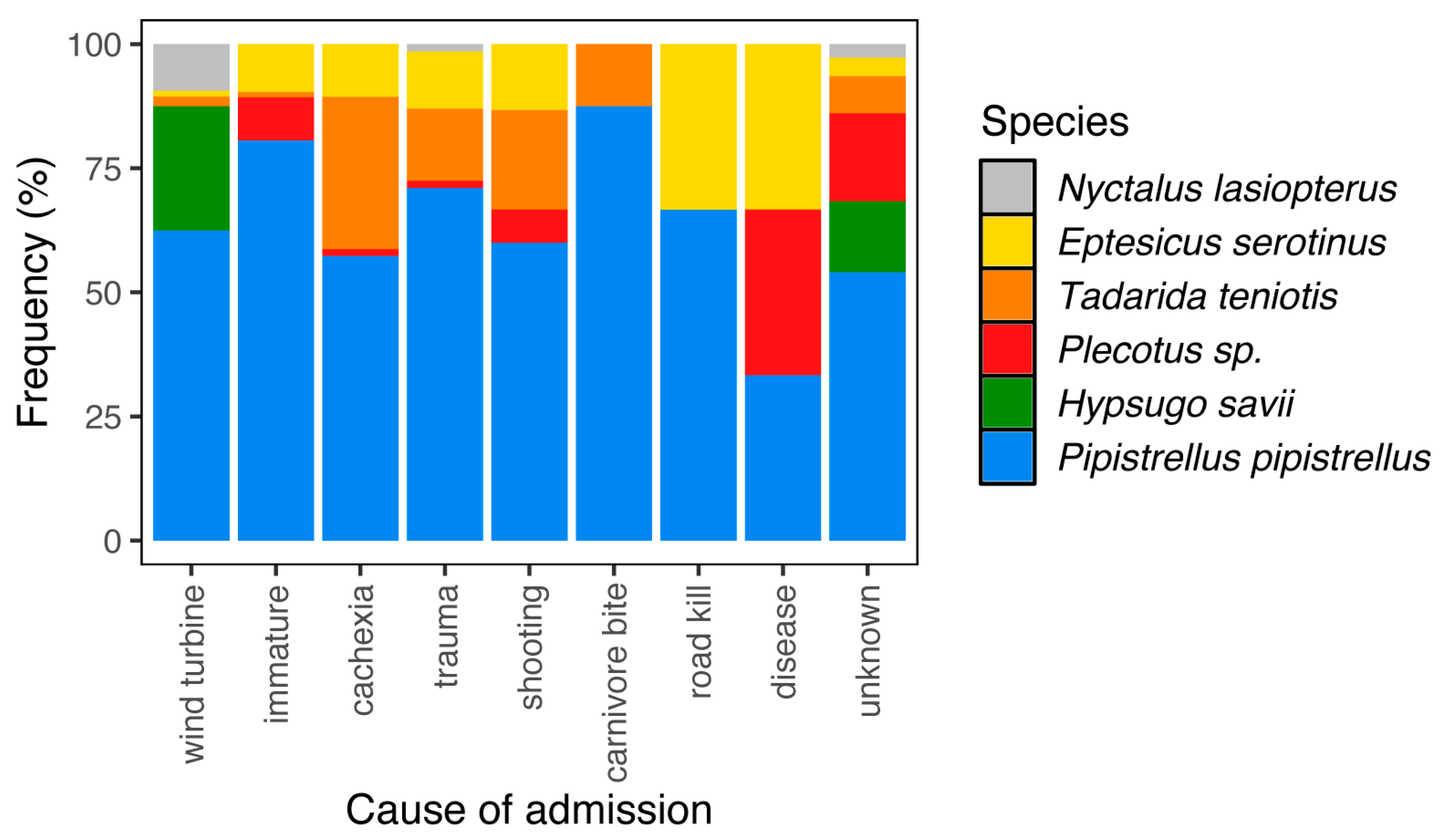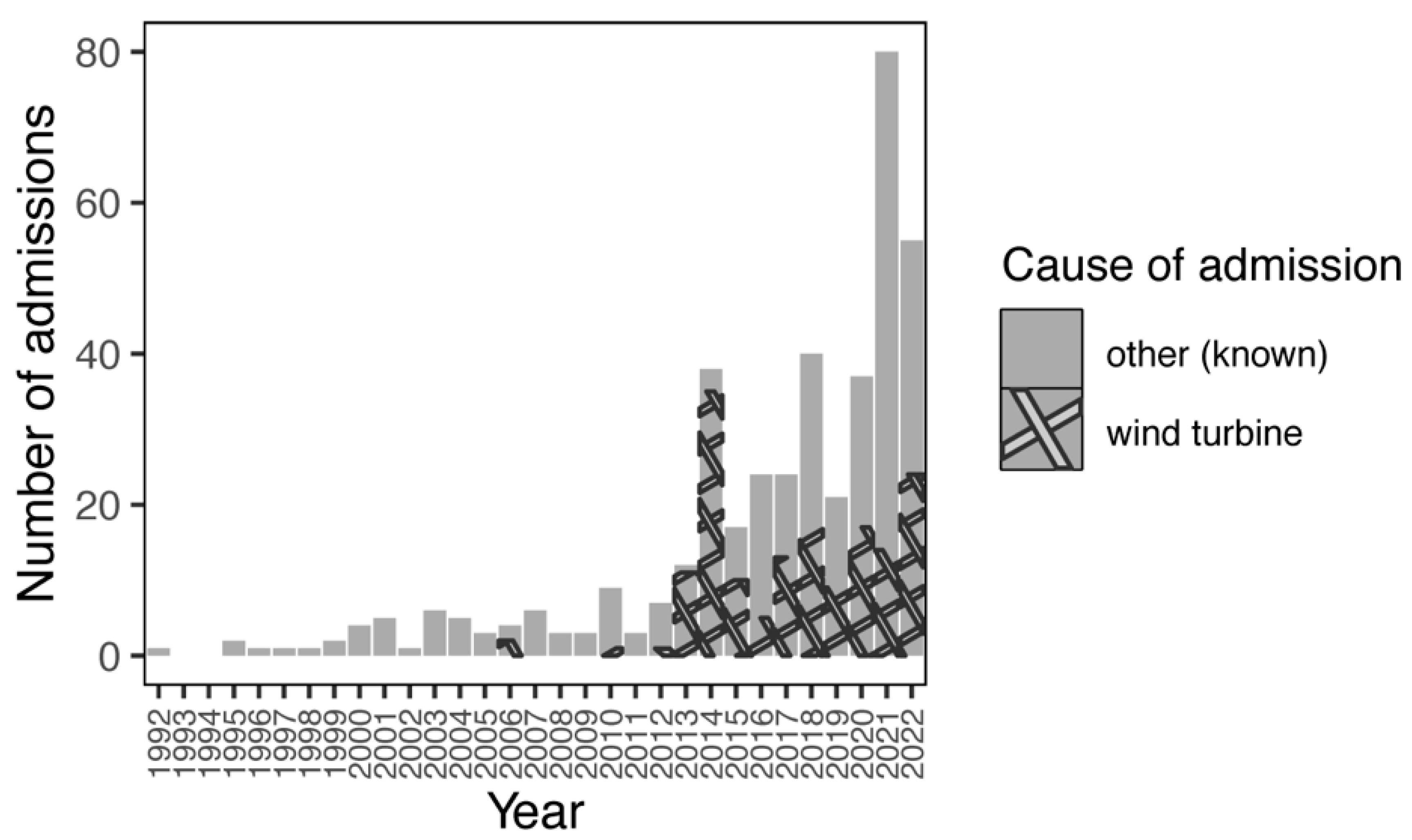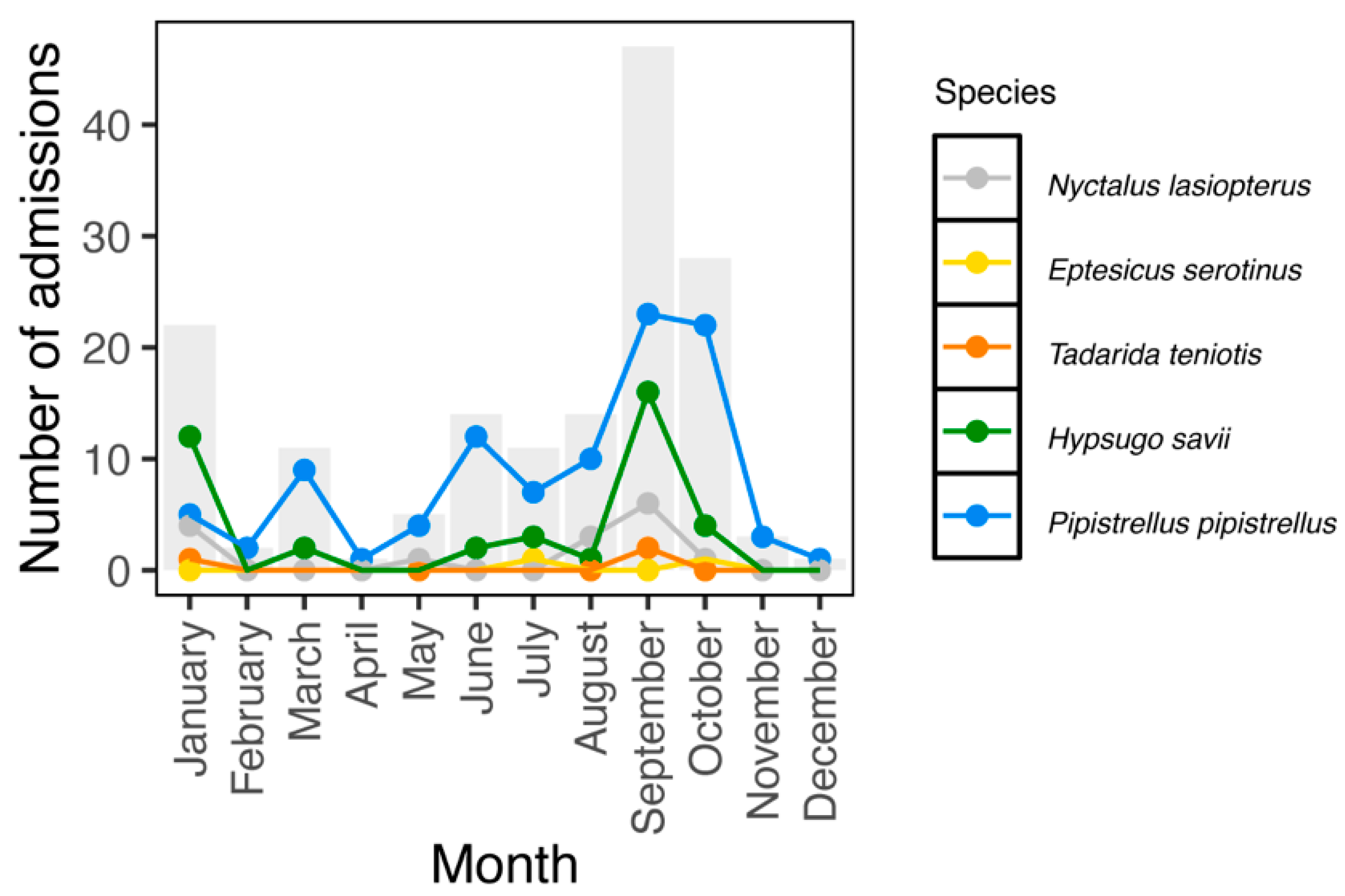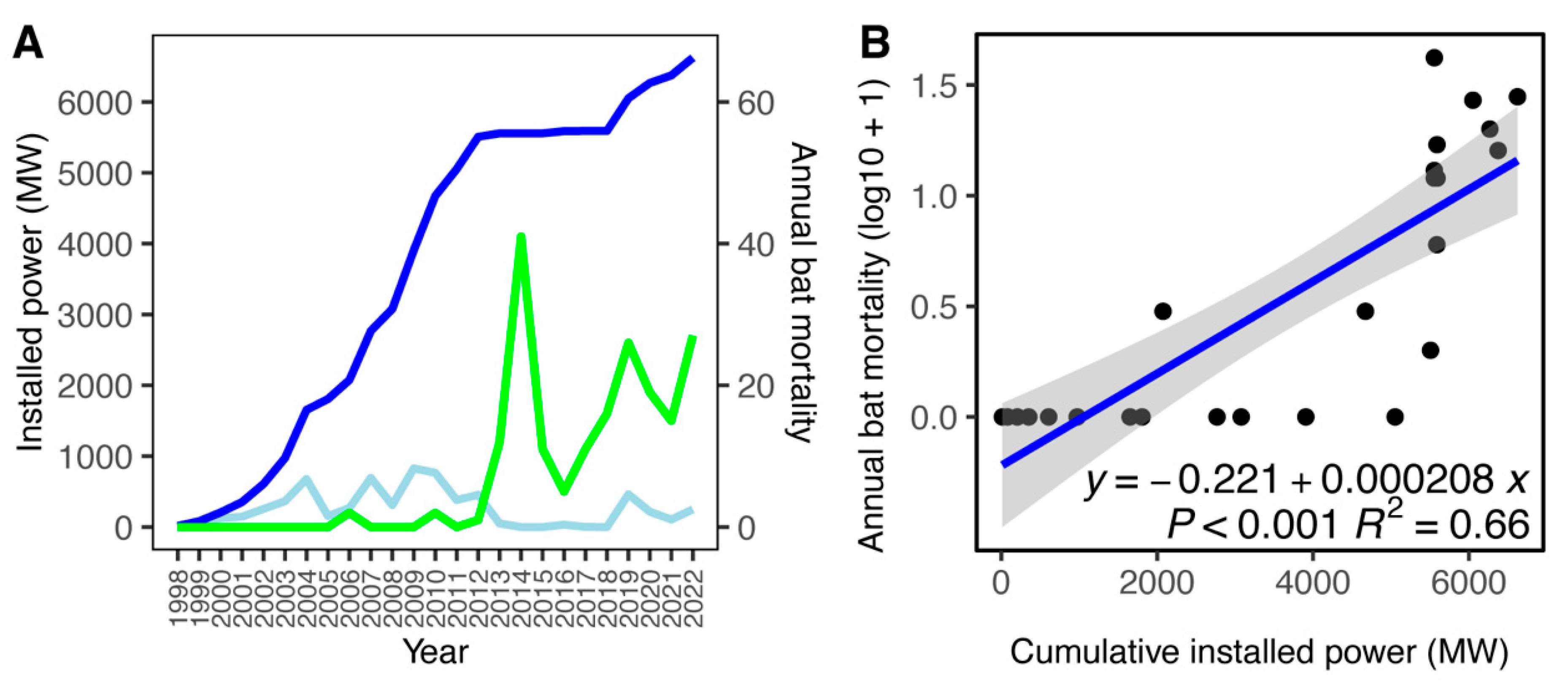Main Causes of Bat Mortality Obtained Through Admission to Rescue Centres
Abstract
1. Introduction
2. Methods
3. Results
4. Discussion
5. Conclusions
Supplementary Materials
Author Contributions
Funding
Data Availability Statement
Acknowledgments
Conflicts of Interest
References
- Mickleburgh, S.P.; Hutson, A.M.; Racey, P.A. A review of the global conservation status of bats. Oryx 2002, 36, 18–34. [Google Scholar] [CrossRef]
- Lane, D.J.; Kingston, T.; Lee, B.P.-H. Dramatic decline in bat species richness in Singapore, with implications for Southeast Asia. Biol. Conserv. 2006, 131, 584–593. [Google Scholar] [CrossRef]
- Kervyn, T.; Lamotte, S.; Nyssen, P.; Verschuren, J. Major decline of bat abundance and diversity during the last 50 years in southern Belgium. Belg. J. Zool. 2009, 139, 124–132. [Google Scholar]
- Mühldorfer, K.; Speck, S.; Kurth, A.; Lesnik, R.; Freuling, C.; Müller, T.; Kramer-Schadt, S.; Wibbelt, G. Diseases and causes of death in European bats: Dynamics in disease susceptibility and infection rates. PLoS ONE 2011, 6, e29773. [Google Scholar] [CrossRef] [PubMed]
- Voigt, C.C.; Kingston, T. Bats in the Anthropocene: Conservation of Bats in a Changing World; Springer Nature: Cham, Switzerland, 2016; p. 606. [Google Scholar]
- Frick, W.F.; Kingston, T.; Flanders, J. A review of the major threats and challenges to global bat conservation. Ann. N. Y. Acad. Sci. 2020, 1469, 5–25. [Google Scholar] [CrossRef]
- Cryan, P.C.; Barclay, R.M.R. Causes of Bat Fatalities at Wind Turbines: Hypotheses and Predictions. J. Mammal. 2009, 90, 1330–1340. [Google Scholar] [CrossRef]
- Grodsky, S.M.; Behr, M.J.; Gendler, A.; Drake, D.; Dieterle, B.D.; Rudd, R.J.; Walrath, N.L. Investigating the causes of death for wind turbine-associated bat fatalities. J. Mammal. 2011, 92, 917–925. [Google Scholar] [CrossRef]
- Thompson, M.; Beston, J.A.; Etterson, M.; Diffendorfer, J.E.; Loss, S.R. Factors associated with bat mortality at wind energy facilities in the United States. Biol. Conserv. 2017, 215, 241–245. [Google Scholar] [CrossRef] [PubMed]
- Lawson, M.; Jenne, D.; Thresher, R.; Houck, D.; Wimsatt, J.; Straw, B. An investigation into the potential for wind turbines to cause barotrauma in bats. PLoS ONE 2020, 15, e0242485. [Google Scholar] [CrossRef]
- Lloyd, J.D.; Butryn, R.; Pearman-Gillman, S.; Allison, T.D. Seasonal patterns of bird and bat collision fatalities at wind turbines. PLoS ONE 2023, 18, e0284778. [Google Scholar] [CrossRef]
- Salguero, M.D.M.; De la Cruz, A.; Muñoz, A.R.; Muñoz Arroyo, G. Bat mortality in wind farms of southern Europe: Temporal patterns and implications in the current context of climate change. Biodivers. Conserv. 2023, 32, 3953–3971. [Google Scholar] [CrossRef]
- Cryan, P.M.; Meteyer, C.U.; Boyles, J.G.; Blehert, D.S. Wing pathology of white-nose syndrome in bats suggests life-threatening disruption of physiology. BMC Biol. 2010, 8, 135. [Google Scholar] [CrossRef]
- Puechmaille, S.J.; Frick, W.F.; Kunz, T.H.; Racey, P.A.; Voigt, C.C.; Wibbelt, G.; Teeling, E.C. White-nose syndrome: Is this emerging disease a threat to European bats? Trends Ecol. Evol. 2011, 26, 570–576. [Google Scholar] [CrossRef]
- Warnecke, L.; Turner, J.M.; Bollinger, T.K.; Lorch, J.M.; Misra, V.; Cryan, P.M.; Wibbelt, G.; Blehert, D.S.; Willis, C.K. Inoculation of bats with European Geomyces destructans supports the novel pathogen hypothesis for the origin of white-nose syndrome. Proc. Natl. Acad. Sci. USA 2012, 109, 6999–7003. [Google Scholar] [CrossRef] [PubMed]
- Gillette, D.D.; Kimbrough, J.D. Chiropteran mortality. Fondren Sci. Ser. 1970, 1, 14. [Google Scholar]
- Beattie, I.; Schofer, D.; McGregor, G.; Lee, M.J.; Lee, L.K.; Himsworth, C.G.; Byers, K.A. An investigation of bat mortality in British Columbia, Canada. Can. J. Zool. 2022, 100, 464–473. [Google Scholar] [CrossRef]
- O’Shea, T.J.; Clark, D.R., Jr. An overview of contaminants and bats, with special reference to insecticides and the Indiana bat. In The Indiana Bat: Biology and Management of an Endangered Species; Bat Conservation International: Austin, TX, USA, 2002; pp. 237–253. [Google Scholar]
- O’Shea, T.J.; Cryan, P.M.; Hayman, D.T.; Plowright, R.K.; Streicker, D.G. Multiple mortality events in bats: A global review. Mammal Rev. 2016, 46, 175–190. [Google Scholar] [CrossRef]
- Pyke, G.H.; Szabo, J.K. Conservation and the 4 Rs, which are rescue, rehabilitation, release, and research. Conserv. Biol. 2018, 32, 50–59. [Google Scholar] [CrossRef]
- Kelly, G.; del Barco-Trillo, J. Importance of taxonomic group, life stage and circumstance of rescue upon wildlife rehabilitation in Ontario, Canada. J. Nat. Conserv. 2020, 57, 125897. [Google Scholar] [CrossRef]
- Long, R.B.; Krumlauf, K.; Young, A.M. Characterizing trends in human-wildlife conflicts in the American Midwest using wildlife rehabilitation records. PLoS ONE 2020, 15, e0238805. [Google Scholar] [CrossRef] [PubMed]
- Vezyrakis, A.; Bontzorlos, V.; Rallis, G.; Ganoti, M. Two decades of wildlife rehabilitation in Greece: Major threats, admission trends and treatment outcomes from a prominent rehabilitation centre. J. Nat. Conserv. 2023, 73, 126372. [Google Scholar] [CrossRef]
- Mazaris, A.D.; Mamakis, Y.; Kalpakis, S.; Poulopoulos, Y.; Matsinos, Y.G. Evaluating potential threats to birds in Greece: An analysis of a 10-year data set from a rehabilitation centre. Oryx 2008, 42, 408–414. [Google Scholar] [CrossRef]
- Molina-López, R.A.; Casal, J.; Darwich, L. Causes of morbidity in wild raptor populations admitted at a wildlife rehabilitation centre in Spain from 1995–2007: A long term retrospective study. PLoS ONE 2011, 6, e24603. [Google Scholar] [CrossRef]
- Balmori, A. Endangered bird mortality by gunshots: Still a current problem. Biodivers. Conserv. 2019, 28, 2555–2564. [Google Scholar] [CrossRef]
- Balmori-de la Puente, A.; Balmori, A. Electrocutions as an important cause of mortality for a mesocarnivore. Mammalia 2024, 88, 504–508. [Google Scholar] [CrossRef]
- Ancillotto, L.; Serangeli, M.T.; Russo, D. Curiosity killed the bat: Domestic cats as bat predators. Mamm. Biol. 2013, 78, 369–373. [Google Scholar] [CrossRef]
- Garcês, A.; Soeiro, V.; Lóio, S.; Pires, I. Causes of morbidity and mortality of bats in a wildlife recovery center in Portugal. J. Bat Res. Conserva 2017, 10, 6. [Google Scholar]
- Salinas-Ramos, V.B.; Tomassini, A.; Ferrari, F.; Boga, R.; Russo, D. Admittance to wildlife rehabilitation centres points to adverse effects of climate change on insectivorous bats. Biology 2023, 12, 543. [Google Scholar] [CrossRef]
- R Core Team. R: A Language and Environment for Statistical Computing; R Foundation for Statistical Computing: Vienna, Austria, 2023. [Google Scholar]
- Junta de Castilla y León. 2022. Available online: https://energia.jcyl.es/web/es/energias-renovables-ordenacion-energetica/parques-eolicos-castilla-leon.html (accessed on 1 June 2023).
- Statista. Available online: https://es.statista.com/estadisticas/498915/potencia-eolica-instalada-en-espana/ (accessed on 1 June 2023).
- Prylutska, A.; Yerofeieva, M.; Bohodist, V.; Shulenko, A.; But, A.; Kravchenko, K.; Prylutskyi, O.; Vlaschenko, A. The dataset of bat (Mammalia, Chiroptera) occurrences in Ukraine collected by the Ukrainian Bat Rehabilitation Center (2011–2022). Biodivers. Data J. 2023, 11, e99243. [Google Scholar] [CrossRef]
- Roemer, C.; Disca, T.; Coulon, A.; Bas, Y. Bat flight height monitored from wind masts predicts mortality risk at wind farms. Biol. Conserv. 2017, 215, 116–122. [Google Scholar] [CrossRef]
- Camiña, Á. Bat fatalities at wind farms in northern Spain—Lessons to be learned. Acta Chiropterol. 2012, 14, 205–212. [Google Scholar] [CrossRef]
- Rnjak, D.; Janeš, M.; Križan, J.; Antonić, O. Reducing bat mortality at wind farms using site-specific mitigation measures: A case study in the Mediterranean region, Croatia. Mammalia 2023, 87, 259–270. [Google Scholar] [CrossRef]
- Palomo, L.J.; Gisbert, J.; Blanco, J.C. (Eds.) Atlas y Libro Rojo de los Mamíferos Terrestres de España; Organismo Autónomo de Parques Nacionales: Madrid, Spain, 2007. [Google Scholar]
- Quetglas, J. Murciélago Ratonero Pardo—Myotis emarginatus. In Enciclopedia Virtual de los Vertebrados Españoles; Salvador, A., Barja, I., Eds.; Museo Nacional de Ciencias Naturales: Madrid, Spain, 2015; Available online: http://www.vertebradosibericos.org/ (accessed on 15 April 2025).
- Quetglas, J. Murciélago ratonero ibérico—Myotis escalerai. In Enciclopedia Virtual de los Vertebrados Españoles; Salvador, A., Barja, I., Eds.; Museo Nacional de Ciencias Naturales: Madrid, Spain, 2016; Available online: http://www.vertebradosibericos.org/ (accessed on 15 April 2025).
- Balmori, A. Murciélago rabudo—Tadarida teniotis. In Enciclopedia Virtual de los Vertebrados Españoles; Salvador, A., Barja, I., Eds.; Museo Nacional de Ciencias Naturales: Madrid, Spain, 2017; Available online: http://www.vertebradosibericos.org/ (accessed on 15 April 2025).
- Alcalde, J.T. Nóctulo mediano—Nyctalus noctula. In Enciclopedia Virtual de los Vertebrados Españoles; Salvador, A., Barja, I., Eds.; Museo Nacional de Ciencias Naturales: Madrid, Spain, 2017; Available online: http://www.vertebradosibericos.org/ (accessed on 15 April 2025).
- Lisón, F. Murciélago hortelano meridional—Eptesicus isabellinus. In Enciclopedia Virtual de los Vertebrados Españoles; Salvador, A., Barja, I., Eds.; Museo Nacional de Ciencias Naturales: Madrid, Spain, 2017; Available online: http://www.vertebradosibericos.org/ (accessed on 15 April 2025).
- Lisón, F. Murciélago de cueva—Miniopterus schreibersii. In Enciclopedia Virtual de los Vertebrados Españoles; Salvador, A., Barja, I., Eds.; Museo Nacional de Ciencias Naturales: Madrid, Spain, 2017; Available online: http://www.vertebradosibericos.org/ (accessed on 15 April 2025).
- Barros, P. Murciélago de Bosque—Barbastella barbastellus. In Enciclopedia Virtual de los Vertebrados Españoles; López, P., Martín, J., Quetglas, J., Eds.; Museo Nacional de Ciencias Naturales: Madrid, Spain, 2023; Available online: http://www.vertebradosibericos.org/ (accessed on 15 April 2025).
- Balmori, A.; Fernández, J. Notas sobre predación en una colonia de quirópteros. Barbastella 1994, 13. [Google Scholar]
- Medinas, D.; Marques, J.T.; Mira, A. Assessing road effects on bats: The role of landscape, road features, and bat activity on road-kills. Ecol. Res. 2013, 28, 227–237. [Google Scholar] [CrossRef]
- Ramalho, D.F.; Aguiar, L. Bats on the Road—A Review of the Impacts of Roads and Highways on Bats. Acta Chiropterol. 2020, 22, 417–433. [Google Scholar] [CrossRef]
- González, F.; Alcalde, J.T.; Ibáñez, C. Directrices Básicas para el Estudio del Impacto de Instalaciones Eólicas Sobre Poblaciones de Murciélagos en España. Barbastella 2013, 6, 1–31. [Google Scholar]
- Barré, K.; Froidevaux, J.S.; Leroux, C.; Mariton, L.; Fritze, M.; Kerbiriou, C.; Roemer, C. Over a decade of failure to implement UNEP/EUROBATS guidelines in wind energy planning: A call for action. Conserv. Sci. Pract. 2022, 4, e12805. [Google Scholar] [CrossRef]




| Species | Condition | Wind Turbine | Immature | Cachexia | Trauma | Shooting | Carnivore Bite | Captivity | Road Kill | Disease | Snare | Electrocution | Unknown | Total |
|---|---|---|---|---|---|---|---|---|---|---|---|---|---|---|
| Pipistrellus pipistrellus | Death | 100 | 48 | 13 | 40 | 1 | 6 | 1 | 2 | 1 | 1 | 1 | 125 | 339 |
| Pipistrellus kuhlii | 10 | 0 | 0 | 0 | 0 | 0 | 0 | 0 | 0 | 0 | 0 | 10 | 20 | |
| Pipistrellus pygmaeus | 3 | 0 | 0 | 0 | 0 | 0 | 0 | 0 | 0 | 0 | 0 | 5 | 8 | |
| Hypsugo savii | 40 | 0 | 0 | 0 | 0 | 0 | 0 | 0 | 0 | 0 | 0 | 42 | 82 | |
| Plecotus sp. | 0 | 2 | 1 | 1 | 1 | 0 | 0 | 0 | 1 | 0 | 0 | 2 | 8 | |
| Tadarida teniotis | 3 | 1 | 4 | 9 | 1 | 1 | 0 | 0 | 0 | 0 | 0 | 20 | 39 | |
| Eptesicus serotinus | 2 | 5 | 1 | 5 | 0 | 0 | 0 | 1 | 0 | 0 | 0 | 4 | 18 | |
| Nyctalus lasiopterus | 15 | 0 | 0 | 1 | 0 | 0 | 0 | 0 | 0 | 0 | 0 | 8 | 24 | |
| Nyctalus leisleri | 8 | 0 | 0 | 0 | 0 | 0 | 0 | 0 | 0 | 0 | 0 | 3 | 11 | |
| Nyctalus noctula | 3 | 0 | 0 | 0 | 0 | 0 | 0 | 0 | 0 | 0 | 0 | 6 | 9 | |
| Myotis myotis | 2 | 0 | 0 | 0 | 0 | 0 | 0 | 0 | 0 | 0 | 0 | 0 | 2 | |
| Myotis nattereri | 1 | 0 | 0 | 0 | 0 | 0 | 0 | 0 | 0 | 0 | 0 | 2 | 3 | |
| Myotis daubentonii | 0 | 0 | 0 | 0 | 0 | 0 | 0 | 0 | 0 | 0 | 0 | 1 | 1 | |
| Miniopterus schreibersii | 2 | 0 | 0 | 0 | 0 | 0 | 0 | 0 | 0 | 0 | 0 | 0 | 2 | |
| Rhinolophus ferrumequinum | 0 | 0 | 0 | 1 | 0 | 0 | 0 | 0 | 0 | 0 | 0 | 1 | 2 | |
| Pipistrellus pipistrellus | Injured | 0 | 27 | 30 | 9 | 8 | 1 | 3 | 0 | 0 | 0 | 0 | 34 | 112 |
| Pipistrellus kuhlii | 0 | 0 | 0 | 0 | 0 | 0 | 0 | 0 | 0 | 0 | 0 | 0 | 0 | |
| Pipistrellus pygmaeus | 0 | 0 | 0 | 0 | 0 | 0 | 0 | 0 | 0 | 0 | 0 | 1 | 1 | |
| Hypsugo savii | 0 | 0 | 0 | 0 | 0 | 0 | 0 | 0 | 0 | 0 | 0 | 0 | 0 | |
| Plecotus sp. | 0 | 6 | 0 | 0 | 0 | 0 | 0 | 0 | 0 | 0 | 0 | 50 | 56 | |
| Tadarida teniotis | 0 | 0 | 19 | 1 | 2 | 0 | 0 | 0 | 0 | 0 | 0 | 2 | 24 | |
| Eptesicus serotinus | 0 | 4 | 7 | 3 | 2 | 0 | 0 | 0 | 1 | 0 | 0 | 7 | 24 | |
| Nyctalus lasiopterus | 0 | 0 | 0 | 0 | 0 | 0 | 0 | 0 | 0 | 0 | 0 | 0 | 0 | |
| Nyctalus leisleri | 0 | 0 | 0 | 0 | 0 | 0 | 0 | 0 | 0 | 0 | 0 | 0 | 0 | |
| Nyctalus noctula | 0 | 0 | 0 | 0 | 0 | 0 | 0 | 0 | 0 | 0 | 0 | 0 | 0 | |
| Myotis myotis | 0 | 0 | 1 | 0 | 1 | 0 | 0 | 0 | 0 | 0 | 0 | 1 | 3 | |
| Myotis nattereri | 0 | 0 | 0 | 0 | 0 | 0 | 0 | 0 | 0 | 0 | 0 | 1 | 1 | |
| Myotis daubentonii | 0 | 0 | 1 | 0 | 0 | 0 | 0 | 0 | 0 | 0 | 0 | 1 | 2 | |
| Miniopterus schreibersii | 0 | 0 | 0 | 0 | 0 | 0 | 0 | 0 | 0 | 0 | 0 | 0 | 0 | |
| Rhinolophus ferrumequinum | 0 | 0 | 0 | 0 | 0 | 0 | 0 | 0 | 0 | 0 | 0 | 0 | 0 | |
| Total | 189 | 93 | 77 | 70 | 16 | 8 | 4 | 3 | 3 | 1 | 1 | 326 | 791 |
Disclaimer/Publisher’s Note: The statements, opinions and data contained in all publications are solely those of the individual author(s) and contributor(s) and not of MDPI and/or the editor(s). MDPI and/or the editor(s) disclaim responsibility for any injury to people or property resulting from any ideas, methods, instructions or products referred to in the content. |
© 2025 by the authors. Licensee MDPI, Basel, Switzerland. This article is an open access article distributed under the terms and conditions of the Creative Commons Attribution (CC BY) license (https://creativecommons.org/licenses/by/4.0/).
Share and Cite
Balmori-de la Puente, A.; Balmori, A. Main Causes of Bat Mortality Obtained Through Admission to Rescue Centres. Diversity 2025, 17, 567. https://doi.org/10.3390/d17080567
Balmori-de la Puente A, Balmori A. Main Causes of Bat Mortality Obtained Through Admission to Rescue Centres. Diversity. 2025; 17(8):567. https://doi.org/10.3390/d17080567
Chicago/Turabian StyleBalmori-de la Puente, Alfonso, and Alfonso Balmori. 2025. "Main Causes of Bat Mortality Obtained Through Admission to Rescue Centres" Diversity 17, no. 8: 567. https://doi.org/10.3390/d17080567
APA StyleBalmori-de la Puente, A., & Balmori, A. (2025). Main Causes of Bat Mortality Obtained Through Admission to Rescue Centres. Diversity, 17(8), 567. https://doi.org/10.3390/d17080567






